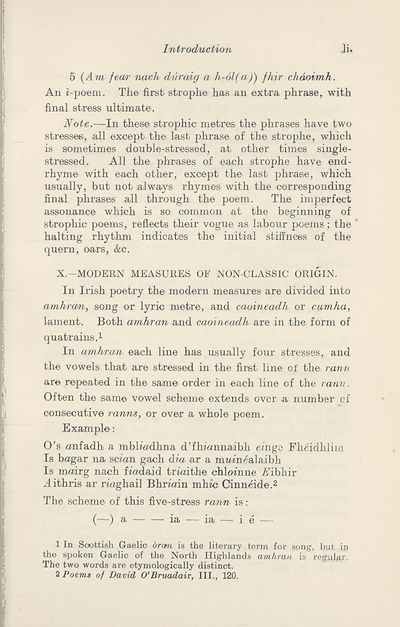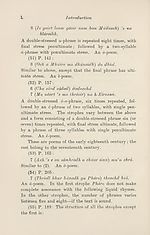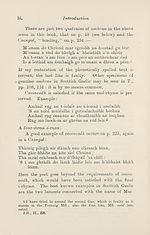Download files
Complete book:
Individual page:
Thumbnail gallery: Grid view | List view

Introduction
Ji.
5 {Am fear nach durmg a h-ol(a)') fhir chdoimh.
An i-poem. The first strophe has an extra phrase, with
final stress ultimate.
Note.—In these strophic metres the phrases have two
stresses, all except the last phrase of the strophe, which
is sometimes double-stressed, at other times single-
stressed. All the phrases of each strophe have end-
rhyme with each other, except the last phrase, which
usually, but not always rhymes with the corresponding
final phrases all through the poem. The imperfect
assonance which is so common at the beginning of
strophic poems, reflects their vogue as labour poems; the
halting rhythm indicates the initial stiffness of the
quern, oars, &c.
X.—MODERN MEASURES OF NON-CLASSIC ORIGIN.
In Irish poetry the modern measures are divided into
amhraxn, song or lyric metre, and caoineadh or cumha,
lament. Both amhran and caoineadh are in the form of
quatrains.1
In amhran each line has usually four stresses, and
the vowels that are stressed in the first line of the rann
are repeated in the same order in each line of the rann.
Often the same vowel scheme extends over a number cf
consecutive ranns, or over a whole poem.
Example:
O’s unfadh a mbbadhna d’fhiannaibh emge Fheidhlim
Is bagar na scion gach Aia ar a mwinealaibh
Is moirg nach fiodaid trmithe chloinne Aibhir
A ithris ar rioghail Bhrioin mhic Cinneide.2
The scheme of this five-stress rann is:
(—) a ia — ia — i e —
1 In Soottish Gaelic dram is the literary term for song, but in
the spoken Gaelic of the North Highlands amhran is regular.
The two words are etymologically distinct.
2 Poems of David O’Bruadaiv, III., 120.
Ji.
5 {Am fear nach durmg a h-ol(a)') fhir chdoimh.
An i-poem. The first strophe has an extra phrase, with
final stress ultimate.
Note.—In these strophic metres the phrases have two
stresses, all except the last phrase of the strophe, which
is sometimes double-stressed, at other times single-
stressed. All the phrases of each strophe have end-
rhyme with each other, except the last phrase, which
usually, but not always rhymes with the corresponding
final phrases all through the poem. The imperfect
assonance which is so common at the beginning of
strophic poems, reflects their vogue as labour poems; the
halting rhythm indicates the initial stiffness of the
quern, oars, &c.
X.—MODERN MEASURES OF NON-CLASSIC ORIGIN.
In Irish poetry the modern measures are divided into
amhraxn, song or lyric metre, and caoineadh or cumha,
lament. Both amhran and caoineadh are in the form of
quatrains.1
In amhran each line has usually four stresses, and
the vowels that are stressed in the first line of the rann
are repeated in the same order in each line of the rann.
Often the same vowel scheme extends over a number cf
consecutive ranns, or over a whole poem.
Example:
O’s unfadh a mbbadhna d’fhiannaibh emge Fheidhlim
Is bagar na scion gach Aia ar a mwinealaibh
Is moirg nach fiodaid trmithe chloinne Aibhir
A ithris ar rioghail Bhrioin mhic Cinneide.2
The scheme of this five-stress rann is:
(—) a ia — ia — i e —
1 In Soottish Gaelic dram is the literary term for song, but in
the spoken Gaelic of the North Highlands amhran is regular.
The two words are etymologically distinct.
2 Poems of David O’Bruadaiv, III., 120.
Set display mode to:
![]() Universal Viewer |
Universal Viewer | ![]() Mirador |
Large image | Transcription
Mirador |
Large image | Transcription
| An Comunn Gàidhealach > An Comunn Gàidhealach Publications > Bàrdachd Ghàidhlig > (55) |
|---|
| Permanent URL | https://digital.nls.uk/126455678 |
|---|
| Description | This contains items published by An Comunn, which are not specifically Mòd-related. It includes journals, annual reports and corporate documents, policy statements, educational resources and published plays and literature. It is arranged alphabetically by title. |
|---|
| Description | A collection of over 400 items published by An Comunn Gàidhealach, the organisation which promotes Gaelic language and culture and organises the Royal National Mòd. Dating from 1891 up to the present day, the collection includes journals and newspapers, annual reports, educational materials, national Mòd programmes, published Mòd literature and music. |
|---|---|
| Additional NLS resources: |
|

